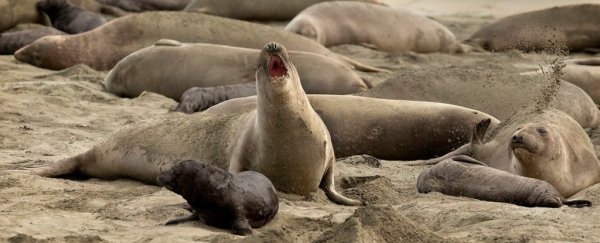It's unclear whether the initial incursion happened stealthily at night or brazenly during the day - though authorities are almost certain the invasion occurred by sea.
And federal employees who returned from the month-long partial government shutdown decided that it was probably not worth the effort to relocate the roughly 90 individuals involved. That's because some of them were pregnant or newborns, and all of them were opportunistic elephant seals that have taken over what used to be the tourist area of Drakes Beach, California.
Across the nation this week, returning federal workers slogged through backlogs of voice mails, sifted through bursting email inboxes and tried to remember the name of the childhood pet at the beginning of their log-in passwords.
At Drakes Beach, part of the Point Reyes National Seashore, employees had a much bigger problem. Literally. Some of the elephant seal squatters weigh as much as a car.
A colony of nearly 1,500 seals inhabits nearby Chimney Beach, which is protected from binocular-wearing tourists by 100-foot-tall cliffs. But Drakes Beach, with its wide swath of sand and spectacular views of the Pacific, has been claimed by humans.
Park officials have used a decidedly low-tech method to enforce an armistice between the mammal species: They waved blue tarps to annoy the seals away from the areas most popular with the homo sapiens.
"It doesn't scare them, and it's a standard technique used with elephant seals," John Dell'Osso, chief of interpretation and resource education for the seashore, told the San Francisco Chronicle. "This would have kept them farther away from tourists."
The annoying tarps were an effective plan, usually chasing all but a seal or two away from the beach, which is a 90-minute drive from San Francisco.
But the federal government apparently does not regard the tarp-wavers as essential federal employees, so the workers who did it were among the 800,000 furloughed.
During that time, according to the Chronicle, high tides and storms battered the seals' normal habitat.
So the seals showed up to the suddenly-deserted Drakes Beach and brought friends, and apparently family, too. Seals give birth during the winter months, and the suddenly-deserted Drakes Beach appears to be an excellent place to raise pups.
On Jan. 27, Point Reyes National Seashore notified eager would-be visitors that Drakes Beach and other popular locations would reopen after the shutdown. Then, four days later, officials posted this:
"Drakes Beach and its access road from Sir Francis Drake Boulevard are temporarily closed to all vehicle, foot, & bicycle traffic due to elephant seal activity in the area."
Pictures of the beach's newest residents showed seals of all sizes sunning themselves in the sand, basking on a beach that provides some of the best views in northern California.
A few have made forays into more human territory. According to Vice, two adult males have been spotted in the parking lot, one on the ramp to the empty visitor center and another beneath a picnic table.
Bulls can weigh as much as 4,500 pounds and, the National Oceanic and Atmospheric Administration warns, "despite their sometimes docile and clumsy appearance, elephant seals can be extremely quick and sometimes vicious if humans, or their pets, get too close."
For the humans of Drakes Beach, it might not be a total surrender. Dell'Osso said staff are exploring the possibility of offering guided tours of the Drakes Beach elephant seal colony.
A similar program happens at Año Nuevo State Park. Visitors who wanted to see the seals at that park are encouraged to bring a warm jacket, water and sturdy walking shoes.
At Drakes Beach, visitors might also consider carrying white flags.
2019 © The Washington Post
This article was originally published by The Washington Post.
